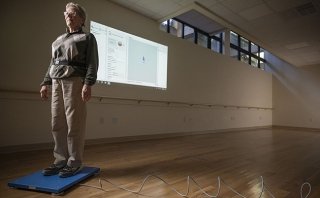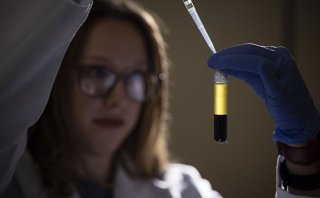
Marian T. Hannan, DSc, MPH
- Senior Scientist
- Professor of Medicine, Harvard Medical School and Beth Israel Deaconess Medical Center
- Professor of Epidemiology, Harvard T.H. Chan School of Public Health
- Faculty
Dr. Marian T .Hannan is a Professor of Medicine at Harvard Medical School and a Senior Scientist at the Hinda and Arthur Marcus Institute for Aging Research. She received her undergraduate degree at the University of California, Berkeley, her Master of Public Health degree at Yale University School of Medicine, and her doctorate in Epidemiology at Boston University School of Medicine. Dr. Hannan is the former Editor-in-Chief of the Arthritis Care & Research Journal.
Dr. Hannan is currently conducting research on risk factors for arthritis, foot disorders and biomechanics, hip fracture, and osteoporosis. She is particularly interested in the effect of biomechanics upon physical function and the influence of body composition. She is widely published with her work represented in many scientific journals in the medical field.
Dr. Hannan is the principal investigator on a number of National Institutes of Health grants with continuous NIH grant funding since 1996. She collaborates on projects with the Framingham study and with the Johnston County Osteoarthritis Project, using the combined expertise of bioengineers, rheumatologists, nutritional epidemiologists, geneticists, molecular biologists, and statisticians to quantify risk factors contributing to musculoskeletal diseases. Dr. Hannan lectures frequently at major institutions. Dr. Hannan looks forward to continuing her leadership in teaching and training of medical and post-doctoral fellows as they build their careers in research.
At Harvard Medical School, Dr. Hannan has taught first-year medical students and directed the Frailty Course at Harvard School of Public Health. Since 2004, Dr. Hannan has served on NIH study sections reviewing national grant applications, as well as providing reviews for many international science organizations. Her mentoring of young investigators includes many scientists and medical fellows in the Boston area as well as 8-10 per year across the U.S. and Canada through the U.S. Bone & Joint Initiative’s Young Investigator Initiative.
My area of expertise is clinical investigational research and my career has focused on modifiable factors related to musculoskeletal disease. My career focuses upon promoting new insights and expanding knowledge on the mechanisms underlying musculoskeletal diseases, such as osteoporosis, osteoarthritis (OA), fracture, sarcopenia (loss of muscle) and common foot disorders. My work examines multiple factors that influence musculoskeletal health with aging, including nutrition and mobility, as well as the role that genes play. As an epidemiologist, I work in a collaborative work model and thus work closely with many investigators to quantify risk factors contributing to these diseases. I have served on numerous NIH study sections reviewing national grant applications as well as serving as a reviewer for many international science organizations. I have been a Board Member for the U.S. Bone & Joint Initiative (sponsored by World Health Organization) and served on the Board of Directors for the American College of Rheumatology as well as many other leadership roles.
My work is well-known for pivotal papers on nutritional aspects of bone health (e.g., the positive effect of dietary protein on bone), seminal work on the population aspects of foot disorders, key methods papers (e.g., the discordance between severity of arthritis and patient reports of pain, how to optimize the tracking of falls in older adults), and scientific insights about the role of foot biomechanics and physical function in older adults. For this latter topic, I sponsored a Senior Fulbright Scholar from Australia during 2011, resulting in international collaborations. In 2018, I co-founded the International Foot and Ankle OA Consortium to develop an international voice that enhances international global collaborations between leading investigators actively involved in foot and ankle OA research.
My teaching responsibilities have included Clinical Epidemiology for first-year HMS students, formal lectures in the Harvard geriatrics fellowship program and Grand Rounds. I am also a Professor of Epidemiology at Harvard T.H. Chan School of Public Health, and since 2012 I have taught a course on ‘Issues of Frailty’ within the Aging Program. My mentoring of young investigators includes many scientists and medical fellows in the Boston area as well as across the U.S. through national venues. Also, I have served as the Editor-in-Chief of the highly-ranked medical journal, Arthritis Care & Research (2011-2021). I lecture frequently at HMS affiliates (e.g., Brigham & Women’s Hospital, MGH, BIDMC), as well other major institutions including Yale University, the University of Connecticut, the Hospital for Special Surgery in NYC, and the University of California.
- Kelsey JL, Berry SD, Procter-Gray E, Quach L, Nguyen US, Li W, Kiel DP, Lipsitz LA, Hannan, MT. Indoor and outdoor Falls in older adults are different: the maintenance of balance, independent living, intellect, and Zest in the Elderly of Boston Study. J Am Geriatr Soc. 2010 Nov;58(11):2135-41. PMCID:PMC2975756
Problem: Falls are a common and often dangerous occurrence for older adults. Most prevention programs and studies combine all falls regardless of location. Failure to separate indoor and outdoor falls for older adults can make it difficult to assess the specific risk factors with falls; in fact, associations may be completely missed when all falls are combined.
This cohort study identified risk factors for indoor and outdoor falls using the MOBILIZE Boston study of 765 older adults in the Boston area via questionnaire and comprehensive clinic examination. Over 2-years of follow-up, 598 indoor and 524 outdoor falls were reported. Risk factors for indoor falls included older age and indicators of poor health. Risk factors for outdoor falls included younger age and being relatively physically active and healthy. For instance, for indoor falls, the age- and sex-adjusted rate ratio was nearly 3-times more likely in those with ‘much difficulty/inability’ in activities of daily living compared to those with no difficulty but the inverse was seen for outdoor falls (RR=0.27; CI: 0.13–0.56). Rate ratio for slow gait (<0.68 m/sec) relative referent gait (>1.33 m/sec) was 1.48 (CI: 0.81–2.68) for indoor falls, but 0.27 (CI: 0.15–0.50) for outdoor falls.
Implications of Research
Risk factors for indoor and outdoor falls differ dramatically. A fall is not necessarily a marker of poor health. Nearly half of the falls in this study occurred outdoors, and people who fall outdoors tended to have the better health than those who do not fall. Combining these falls (as done in many studies), masks important information. Prevention recommendations for older people should be more effective if targeted differently for frail, inactive older people at high risk for indoor falls and relatively active, healthy people at high risk for outdoor falls.
- Hannan MT, Menz HB, Jordan JM, Cupples LA, Cheng CH, Hsu YH. Hallux valgus and lesser toe deformities are highly heritable in adult men and women: The Framingham Foot Study. Arthritis Care Res (Hoboken). 2013 Sep; 65(9):1515-21. doi: 10.1002/acr.22040. PMCID: PMC3775916
Problem: While many report that hallux valgus runs in families, there have been no published peer reviewed studies in humans beyond case reports. Structural foot disorders are common, affecting up to 60% of older adults and are linked with mobility limitations. Are they heritable?
This paper reported the first study in humans that showed hallux valgus to be highly heritable in men and women, in fact, more heritable than height. The study was to estimate the heritability of 3 common foot disorders: hallux valgus, lesser toe deformities, and plantar soft tissue atrophy in 1,370 adults. Significant heritability was found for hallux valgus (range 0.29–0.89, depending on age and sex) and lesser toe deformity (range 0.49–0.90, depending on age and sex). These findings confirm the widely-held clinician view that hallux valgus and lesser toe deformities are highly heritable, underscoring the importance of identifying the underlying genetic susceptibility to these common foot disorders.
Implications of Research
This study reveals new findings in an area that has received little attention, yet is critically important to general populations, especially for mobility and physical activity. Identifying genetic determinants linked to the risk of foot disorders can further our understanding of the biologic mechanisms underlying these foot disorders, with an eye toward early prevention.
- Riskowski JL, Dufour AB, Hagedorn TJ, Hillstrom HJ, Casey VA, Hannan MT. Associations of foot posture and function to lower extremity pain: results from a population-based foot study. Arthritis Care Res. 2013 Nov;65(11):1804-12. doi: 10.1002/acr.22049.
Problem: we have no information outside of young persons in a laboratory-setting about foot posture and foot function in relation to lower extremity pain. What is the empirical population-based evidence for this assertion?
This study looked at pain reported in the hip, knee, ankles or feet in relation to foot posture (planus or flat feet, normal or rectus, and cavus or high arch) as well as foot function (over-pronated, normal or over-supinated). Individuals with planus foot posture had 1.5 higher odds of knee or ankle pain, whereas those with a cavus foot posture had 8 times increased odds of ankle pain. The only finding for foot function was a reduced risk of hip pain in those who over-supinate. These findings offer a link between foot posture and pain further up the kinetic chain, highlighting the need for intervention studies in the population.
Implications of Research
Lower extremity joint pain is highly prevalent. Suspected but under-investigated risk factors for pain at the hip, knee, ankle or foot joint pain may include foot posture and foot function. This study suggest that having poor foot posture (cavus or planus) is linked to a greater risk of joint pain, whereas poor foot function (over-pronated or over-supinated) showed little effect. Foot posture is modifiable (e.g., using foot orthoses, shoewear), whereas most common risk factors (e.g., older age, obesity) are less modifiable, suggesting another avenue for the prevention and/or treatment of knee and ankle pain in adults. These findings offer preliminary support of a mechanistic link between foot posture and lower extremity pain.
| 1997 | Young Investigator Award American Society for Bone & Mineral Research |
| 2000 | Distinguished Scholar Award Association of Rheumatology Health Professionals |
| 2001 | President’s Award Association of Rheumatology Health Professionals (Awarded for outstanding contributions to Clinical Care Textbook) |
| 2003 | Excellence in Teaching Award 1st Year Student Committee at Harvard Medical School (Awarded for teaching Clinical Epidemiology to 1st year medical students) |
| 2005 | 40th Anniversary Star Award Association of Rheumatology Health Professionals (Awarded for important research contributions to rheumatology) |
| 2008 | Nominee, Excellence in Teaching Harvard Medical School |
| 2009 | Distinguished Lecturer American College of Rheumatology (ACR/ARHP) (Selected to present distinguished body of original research at the annual scientific meeting) |
| 2010 | Master Educator American College of Rheumatology (ACR/ARHP) (awarded for national teaching & mentoring of rheumatology fellows and graduate students) |
| 2013 | A. Clifford Barger Prize for Excellence in Mentorship Harvard Medical School |
| 2015 | Excellence in Tutorial Facilitation The Academy at Harvard Medical School (Awarded for teaching 1st year medical students, Clinical Epidemiology & Population Health) |
| 2016 | Excellence in Investigative Mentoring Award American College of Rheumatology (Awarded for contributions to the rheumatology profession through outstanding mentoring) |
| 2019 | Fellow American Society for Bone & Mineral Research (awarded for meritorious and Senior scientific contributions to the bone and osteoporosis field) |
| 2021 | Gideon A. Rodan Excellence in Mentoring Award American Society for Bone & Mineral Research (International award for mentoring the next generation of bone scientists & investigators) |
| 2021 | Master Designation Association of Rheumatology Professionals, American College of Rheumatology (Awarded for contributions to rheumatology and amplifying patient care in the next generation) |
| 2022 | Lifetime Achievement Award Association of Rheumatology Professionals, American College of Rheumatology (Awarded for sustained and significant contributions to rheumatology in a distinguished career) |
In addition to my work at Hebrew SeniorLife, Harvard Medical School and Harvard T.H. Chan School of Public Health, I collaborate extensively with groups across the globe, including:
- University of North Carolina, Chapel Hill, NC
- Hospital for Special Surgery, NYC, NY
- University of Massachusetts, Lowell, MA
- Boston University School of Public Health, Boston MA
- Washington University in St. Louis, St. Louis MO
- La Trobe University, Victoria AU
- University of Keele, Keele UK
- University of Melbourne, Melbourne AU
- Leeds University, Leeds UK
- University of Southampton, Southampton UK
and several international collaborative efforts, including:
- The Bone Microarchitecture International Consortium (BoMIC)
- OMERACT (Outcome Measures in Rheumatology Clinical Trials)
- IFAOC (International Foot & Ankle Osteoarthritis Collaboration)




